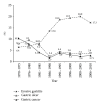The changing pattern of upper gastrointestinal disorders by endoscopy: data of the last 40 years
- PMID: 25276089
- PMCID: PMC4170704
- DOI: 10.1155/2014/262638
The changing pattern of upper gastrointestinal disorders by endoscopy: data of the last 40 years
Abstract
Objectives. We have investigated the changes in the incidence of various diagnoses that have been made in the endoscopy unit throughout the last 40 years. Methods. In this study, changes in the incidence of endoscopic diagnosis in upper gastrointestinal system between 1970 and 2010 were evaluated. Their diagnosis, age, and gender data were entered into the Excel software. Results. Of the 52816 cases who underwent esophagogastroduodenoscopy in the 40-year time period, the mean age was 48.17 ± 16.27 (mean ± SD). Although overall more than half of the patients were male (54.3%), in 1995 and after a marked increase was seen in the proportion of female gender (51-55%). The presence of hiatal hernia, reflux esophagitis, and the number of Barrett's esophaguses significantly increased. Erosive gastritis showed gradual increase, while the number of gastric ulcers decreased significantly. The presence of gastric and esophageal cancer significantly decreased. The number of duodenal ulcers significantly decreased. Conclusion. We detected that the incidences of esophagitis, Barrett's esophagus, and erosive gastritis significantly increased while the incidences of gastric/duodenal ulcer and gastric/esophageal cancer decreased throughout the last 40 years.
Figures




Similar articles
-
Erosive esophagitis and Barrett's esophagus in Taiwan: a higher frequency than expected.Dig Dis Sci. 1997 Apr;42(4):702-6. doi: 10.1023/a:1018835324210. Dig Dis Sci. 1997. PMID: 9125635
-
Prevalence of Helicobacter pylori infection in 190 control subjects and in 236 patients with gastroesophageal reflux, erosive esophagitis or Barrett's esophagus.Dis Esophagus. 1997 Jan;10(1):38-42. doi: 10.1093/dote/10.1.38. Dis Esophagus. 1997. PMID: 9079272
-
The prevalence of Barrett's esophagus and erosive esophagitis in a tertiary referral center in Turkey.Turk J Gastroenterol. 2006 Jun;17(2):79-83. Turk J Gastroenterol. 2006. PMID: 16830286
-
Diagnosis and Management of Low-Grade Dysplasia in Barrett's Esophagus: Expert Review From the Clinical Practice Updates Committee of the American Gastroenterological Association.Gastroenterology. 2016 Nov;151(5):822-835. doi: 10.1053/j.gastro.2016.09.040. Epub 2016 Oct 1. Gastroenterology. 2016. PMID: 27702561 Review.
-
Prevalence of Helicobacter pylori infection in 160 patients with Barrett's oesophagus or Barrett's adenocarcinoma.Aust N Z J Surg. 2000 Jan;70(1):26-33. doi: 10.1046/j.1440-1622.2000.01737.x. Aust N Z J Surg. 2000. PMID: 10696939 Review.
Cited by
-
Essential Oils Derived from Momordica charantia Seeds Exhibited Antiulcer Activity against Hydrogen Chloride/Ethanol and Indomethacin.Evid Based Complement Alternat Med. 2021 Apr 22;2021:5525584. doi: 10.1155/2021/5525584. eCollection 2021. Evid Based Complement Alternat Med. 2021. PMID: 33976701 Free PMC article.
References
-
- Goh K-L, Wong H-T, Lim C-H, Rosaida MS. Time trends in peptic ulcer, erosive reflux oesophagitis, gastric and oesophageal cancers in a multiracial Asian population. Alimentary Pharmacology and Therapeutics. 2009;29(7):774–780. - PubMed
-
- Shaheen N, Provenzale D. The epidemiology of gastroesophageal reflux disease. The American Journal of the Medical Sciences. 2003;326(5):264–273. - PubMed
-
- Sarıoğlu M, Kabaçam G, Bektas M, et al The change in esophagitis detection rates during the last two decades at an endoscopy cented. Endoskopi. 2009;17:1–5.
-
- Yeh C, Hsu C-T, Ho A-S, Sampliner RE, Fass R. Erosive esophagitis and Barrett's esophagus in Taiwan: a higher frequency than expected. Digestive Diseases and Sciences. 1997;42(4):702–706. - PubMed
LinkOut - more resources
Full Text Sources
Other Literature Sources
